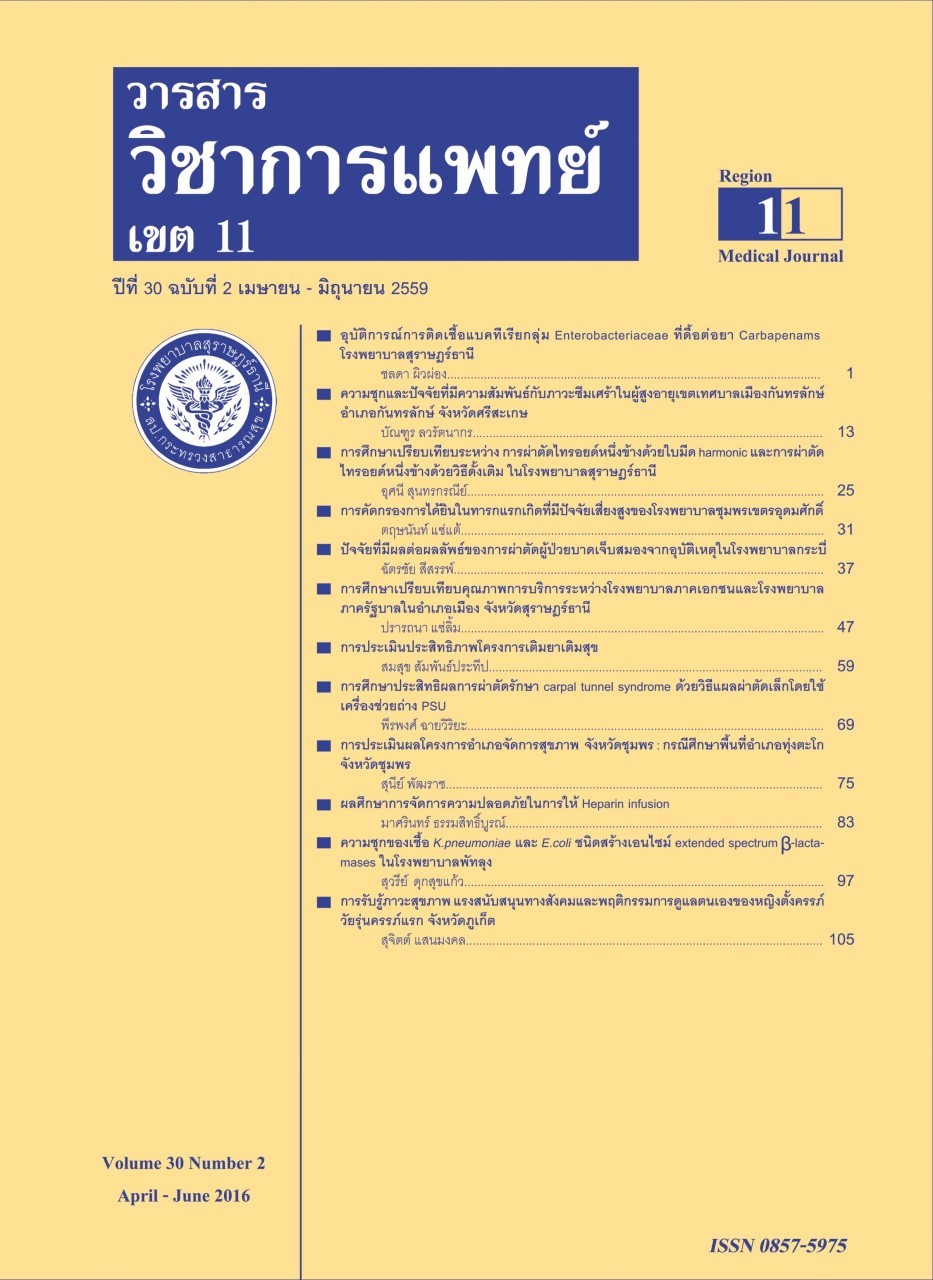Study of Medication safety management for heparin infusion
Keywords:
Heparin infusion, heparin protocol, preprinted order form, medication safety, medication error, adverse drug eventAbstract
Medication errors related to heparin infusion are common and life threatening making heparin one of the high alert drugs in clinical practice. Multiple factors make effective and safe use of heparin infusion very challenging. Achieving a therapeutic level of heparin timely requires proper dosing and highly rigorous drug monitoring to reduce bleeding risks. Heparin had been reported to result in twice the number of complications compared to other drugs.
Some were life-threatening complications. Unfortunately, the level Fincident have been reported at the Chumphon khet Udomsakdi hospital. In 2014, our Multidisciplinary medication safety committeedeveloped practice guidelines aimed at optimizing management and improving safety of heparin infusion. A pre-printed order form used to standardize heparin infusion was implemented in 2014. We conducted a retrospective review of medical records to monitor
effectiveness of the guidelines including metrics for adherence to the process, effective use, safety and unintended consequences. More specifically, pre (2013) vs. post (2014) implementation using aPPT as the outcome variables. The results were reported using descriptive statistics. Fisher’s exact test and odds ratio were used for group comparisons.
From total 11 patient records in 2014, only 36.4% patients were managed using the pre-printed order form. There was no difference in proportion of patients (pre vs. post) reaching aPPT target within 24 hour (odds ratios-OR=9, 95% confidence interval-CI 0.72, 113.02, p=0.1, Fisher’sexact test). There was no difference in proportion of patient achieving steady state (OR 4.33, 95% CI 0.42, 44.3, p=0.25). The rate of repeated level of aPPT (>180 sec) in 2014 is lower than in2013 but the difference did not reach statistical significance. The small sample size of this study may increase the probability of type II error (a ‘false’ negative) within the data analysis.
References
bleeding? 2010 [cited 2015Jul16]. Available from:http://www.ismp.org/newsletters/acutecare/articles/20100408.asp
2. Pangilinan JM. Medscape Log In [online]. Current Issues in Heparin Dosing. 2007 [cited 2016Jan27].Available from: http://www.medscape.com/viewarticle/559442
3. Dager WE. Heparin: Improving Treatment and Reducing Risk of Harm [online]. Heparin: Improving Treatment and Reducing Risk of Harm. 2009 [cited 2016Jan30]. Available from: http://psqh.com/heparinimproving-treatment-and-reducing-risk-of-harm
4. Raschke RA, Reilly BM, Guidry JR, Fontana JR,Srinivas S. The weight-based heparin dosing noomogram compared with a "standard care" nomogram. A randomized controlled trial. Ann Intern Med. 1993;119:874-881.
5. สถาบันพัฒนาและรับรองคุณภาพโรงพยาบาล. Patient safety goal : SIMPLE ; 2551:หน้า 21-22
6. Haffman NB. Heparin Dosing Order Form Use in an Academic-Affiliated Veterans Affairs Medical Center. Journal of Pharmacy Technology [online].1996;12(6):276–9. [cited 2016April03]. Retrieved from:http://pmt.sagapub.com/content/13/6/276.short
7. ISMP’s Guidelines for Standard Order Sets [Internet]. Institution for Safe Medication Practices; 2010 [cited 2016 Apr3]. Retrieved from: http://www.ismp.
org/tools/guidelines/standardordersets.pdf
8. ภาควิชาพยาธิวิทยาคลินิก คณะแพทยศาสตร์ศิริราชพยาบาล มหาวิทยาลัยมหิดล คู่มือการส่งตรวจทางห้องปฏิบัติการ [online] ที่มา : http://www.si.mahidol.ac.th/
th/manual/Project/Document/A/Activated%20Partial%20Thromboplastin%20Time%20(APTT),%20APTT%20ratio.htm [วันที่อ้างถึง 17เมษายน 2557]
9. Ehringer G, Duffy B. Promoting Best Practice and Safety Through Preprinted Physicain Order [Internet].Promoting Best Practice and Safety Through Preprinted
Physicain Order. [cited 2016Apr3]. Retrieved from: http://www.ahrq.gov/sites/default/files/wysiwyg/professionals/quality-patient-safety/patient-safety-resources/
resources/advances-in-patient-safety-2/vol2/advances-ehringer_17.pdf
10. Tahir R. A review of unfractionated heparin and its monitoring. Us Pharmacist. 2007:32(7):HS-26-HS-36






